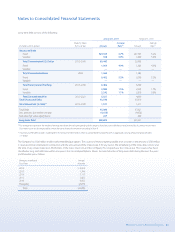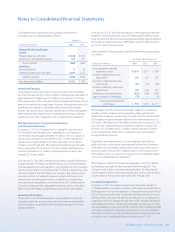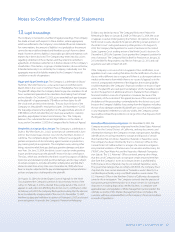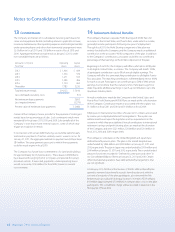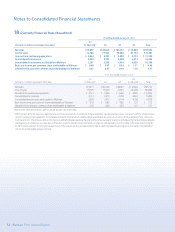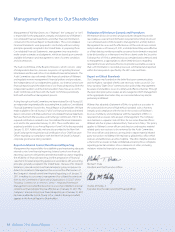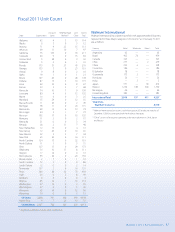Walmart 2011 Annual Report Download - page 49
Download and view the complete annual report
Please find page 49 of the 2011 Walmart annual report below. You can navigate through the pages in the report by either clicking on the pages listed below, or by using the keyword search tool below to find specific information within the annual report.
Walmart 2011 Annual Report 47
12 Legal Proceedings
The Company is involved in a number of legal proceedings. The Company
has made accruals with respect to these matters, where appropriate,
which are reected in the Company’s consolidated nancial statements.
For some matters, the amount of liability is not probable or the amount
cannot be reasonably estimated and therefore accruals have not been
made. However, where a liability is reasonably possible and material, such
matters have been disclosed. The Company may enter into discussions
regarding settlement of these matters, and may enter into settlement
agreements, if it believes settlement is in the best interest of the Company’s
shareholders. The matters, or groups of related matters, discussed below,
if decided adversely to or settled by the Company, individually or in the
aggregate, may result in liability material to the Company’s nancial
condition or results of operations.
Wage-and-Hour Class Action: The Company is a defendant in Braun/
Hummel v. Wal-Mart Stores, Inc., a class action lawsuit commenced in
March 2002 in the Court of Common Pleas in Philadelphia, Pennsylvania.
The plaintis allege that the Company failed to pay class members for all
hours worked and prevented class members from taking their full meal
and rest breaks. On October 13, 2006, a jury awarded back-pay damages
to the plaintis of approximately $78 million on their claims for o-
the-clock work and missed rest breaks. The jury found in favor of the
Company on the plaintis’ meal-period claims. On November 14, 2007,
the trial judge entered a nal judgment in the approximate amount of
$188 million, which included the jury’s back-pay award plus statutory
penalties, prejudgment interest and attorneys’ fees. The Company
believes it has substantial factual and legal defenses to the claims at
issue, and on December 7, 2007, the Company led its Notice of Appeal.
Gender Discrimination Class Action: The Company is a defendant in
Dukes v. Wal-Mart Stores, Inc., a class-action lawsuit commenced in June
2001 in the United States District Court for the Northern District of
California. The complaint alleges that the Company has engaged in a
pattern and practice of discriminating against women in promotions,
pay, training and job assignments. The complaint seeks, among other
things, injunctive relief, front pay, back pay, punitive damages and attor-
neys’ fees. On June 21, 2004, the district court issued an order granting
in part and denying in part the plaintis’ motion for class certication.
The class, which was certied by the district court for purposes of liability,
injunctive and declaratory relief, punitive damages and lost pay, subject
to certain exceptions, includes all women employed at any Wal-Mart
domestic retail store at any time since December 26, 1998, who have
been or may be subjected to the pay and management track promotions
policies and practices challenged by the plaintis.
On August 31, 2004, the United States Court of Appeals for the Ninth
Circuit granted the Company’s petition for discretionary review of the
ruling. On February 6, 2007, a divided three-judge panel of the court of
appeals issued a decision arming the district court’s certication order.
On February 20, 2007, the Company led a petition asking that the decision
be reconsidered by a larger panel of the court. On December 11, 2007,
the three-judge panel withdrew its opinion of February 6, 2007, and issued
a revised opinion. As a result, the Company’s Petition for Rehearing
En Banc was denied as moot. The Company led a new Petition for
Rehearing En Banc on January 8, 2008. On February 13, 2009, the court
of appeals issued an Order granting the Petition. On April 26, 2010, the
Ninth Circuit issued a divided (6-5) opinion arming certain portions of
the district court’s ruling and reversing other portions. On August 25,
2010, the Company led a petition for a writ of certiorari to the United
States Supreme Court seeking review of the Ninth Circuit’s decision. On
December 6, 2010, the Supreme Court granted the Company’s petition for
writ of certiorari. The Company led its Brief for Petitioner on January 20,
2011; the Brief for Respondents was led on February 22, 2011; and oral
argument was held on March 29, 2011.
If the Company is not successful in its appeal of class certication, or an
appellate court issues a ruling that allows for the certication of a class or
classes with a dierent size or scope, and if there is a subsequent adverse
verdict on the merits from which there is no successful appeal, or in the
event of a negotiated settlement of the litigation, the resulting liability
could be material to the Company’s nancial condition or results of oper-
ations. The plaintis also seek punitive damages which, if awarded, could
result in the payment of additional amounts material to the Company’s
nancial condition or results of operations. However, because of the
uncertainty of the outcome of the appeal, because of the uncertainty of
the balance of the proceedings contemplated by the district court, and
because the Company’s liability, if any, arising from the litigation, including
the size of any damages awarded if plaintis are successful in the litigation
or any negotiated settlement, could vary widely, the Company cannot
reasonably estimate the possible loss or range of loss that may arise from
the litigation.
Hazardous Materials Investigations: On November 8, 2005, the
Company received a grand jury subpoena from the United States Attorney’s
Office for the Central District of California, seeking documents and
information relating to the Company’s receipt, transportation, handling,
identication, recycling, treatment, storage and disposal of certain
merchandise that constitutes hazardous materials or hazardous waste.
The Company has been informed by the U.S. Attorney’s Oce for the
Central District of California that it is a target of a criminal investigation
into potential violations of the Resource Conservation and Recovery Act
(“RCRA”), the Clean Water Act and the Hazardous Materials Transporta-
tion Statute. This U.S. Attorney’s Oce contends, among other things,
that the use of Company trucks to transport certain returned merchan-
dise from the Company’s stores to its return centers is prohibited by
RCRA because those materials may be considered hazardous waste.
The government alleges that, to comply with RCRA, the Company must
ship from the store certain materials as “hazardous waste” directly to a
certied disposal facility using a certied hazardous waste carrier. The
U.S. Attorney’s Oce in the Northern District of California subsequently
joined in this investigation. The Company contends that the practice of
transporting returned merchandise to its return centers for subsequent
disposition, including disposal by certied facilities, is compliant with
applicable laws and regulations. While management cannot predict the
ultimate outcome of this matter, management does not believe the
outcome will have a material eect on the Company’s nancial condition
or results of operations.
Notes to Consolidated Financial Statements






